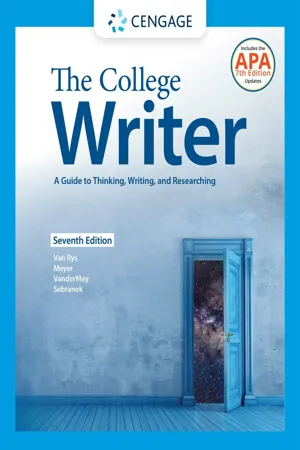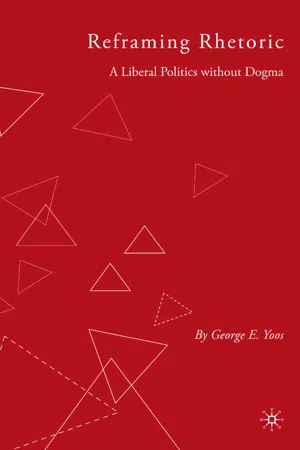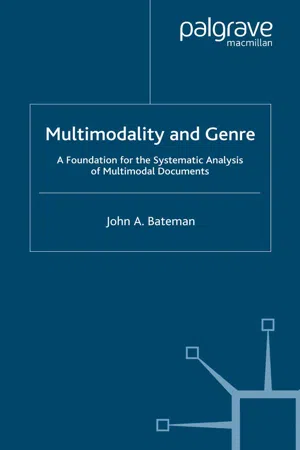Languages & Linguistics
Basic Rhetorical Modes
Basic rhetorical modes are patterns of organization used to achieve specific purposes in writing or speaking. The four main modes are narration (telling a story), description (creating a sensory experience), exposition (explaining or informing), and argumentation (persuading or convincing). These modes help writers and speakers effectively communicate their ideas and engage their audience.
Written by Perlego with AI-assistance
Related key terms
1 of 5
4 Key excerpts on "Basic Rhetorical Modes"
- eBook - ePub
Writing Put to the Test
Teaching for the High Stakes Essay
- Amy Benjamin(Author)
- 2013(Publication Date)
- Routledge(Publisher)
IIRhetorical Modes
Passage contains an image
5
Teaching Writing Through Rhetorical Modes
Because much of our understanding of the world comes through the recognition of patterns, it is extremely helpful to understand how writing topics fall into the following major rhetorical modes: ♦ Narration ♦ Description ♦ Cause and effect ♦ Classification and division ♦ Comparison/contrast It should be noted that some writing texts condense these categories onto only four rhetorical modes: narration, description, exposition, and persuasion.Each rhetorical mode accomplishes its own purpose. Each comes with its own structure and language. Most text is organized around a predominant rhetorical mode, supported by at least one secondary mode. For example, narration often partners up with description; definition partners with exemplification.Teaching writing through the rhetorical modes, which are also called discourse modes, goes way back to Aristotle. However, this paradigm for teaching writing lost its place at the table of writing instruction in the 1970s and 1980s when “process pedagogy” came into favor. Actually, there’s no reason why instruction in the rhetorical modes needs to compete with writing process instruction: both can be mutually supportive. The advantage of teaching writing through the rhetorical modes, as we will see, is that once we know what mode we’re in, we can build within an existing structure that we already understand.Karen Gocsik, executive director of the writing program at Dartmouth College, says this about discourse mode pedagogy:[M]odes of discourse instruction can be used to lead students systematically through a hierarchical system of cognitive functions. In these classrooms, professors develop assignments that progress through the modes, moving students from the personal narrative to the analytical argument, and from simple organizational strategies that are chronological and spatial, to more complex organizational strategies that are more formally logical. In this way, modes of discourse instruction sharpen students’ critical and analytical skills. - John Van Rys, Verne Meyer, Randall VanderMey, Patrick Sebranek, John Van Rys(Authors)
- 2021(Publication Date)
- Cengage Learning EMEA(Publisher)
The Modes as Thinking Frameworks Each rhetorical mode involves a thinking move that allows you to deepen your understanding of a topic, to explore it and make claims about it. Personal-Writing Modes Personal-writing modes focus on experience, especially the writer’s experience—whether of places, people, or events—with the goal of vividly sharing that experience with readers. (See chapter 10.) • Narration tells a story, whether in the form of a brief anecdote, a personal essay, a short story, or a book-length novel. • Description evokes material reality (e.g., birds outside a window) through appealing to the senses (sight, hearing, touch, taste, and smell). • Reflection involves rumination—a kind of speculation that extends narration and description toward personal and universal meaning. Analytical Modes Analytical modes involve mentally “breaking down” a topic in an effort to reveal structures and logical relationships that hold it together. • Definition seeks to clarify the meaning of a term or concept (e.g., human trafficking, mathematics, excellence). (See chapter 11.) • Classification organizes into categories large or complex sets of things: weight lifters and their motivations, musical genres popular in Latin America, or positions on climate change. (See chapter 12.) • Process analysis explains how a specific phenomenon unfolds in time—stage by stage, step by step. The phenomenon might be natural (the development of cancer), historical (emancipation), or cultural (end-of-life care). (See chapter 13.) • Compare-contrast analysis examines the similarities and/or differences between two or more topics in order to illuminate their distinctiveness and/or their commonalities, whether the topics are cultural characteristics, human and animal suffering, or traditional and cyber bullying. (See chapter 14.) • Cause-effect analysis examines the forces that bring about specific results—focusing on the forces at work (causes), the results (effects), or both.- eBook - PDF
Reframing Rhetoric
A Liberal Politics Without Dogma
- G. Yoos(Author)
- 2007(Publication Date)
- Palgrave Macmillan(Publisher)
In form they are usually expository. Rhetorical genres are usually categorized by aims. A rhetorical genre has a conventional form or mode of presentation. As such, genre are especially defined by style and arrangement. If our aim is to praise someone, we give an encomium. If we choose to memo- rialize the dead, we give a eulogy. If we wish to introduce someone, we make an introduction. If we wish to describe or make a judgment about a book, we write a book review. If we wish to explore an idea, we write an essay. If we wish to nar- rate someone’s life story, we write a biography. If we wish to describe someone’s character, we give or write a character sketch. If we wish to narrate our own life’s story, we write an autobiography. If we wish even to let people in on our deep dark secrets, we write confessions. If we wish to relate intimately or formally with someone about matters of personal concern or business, we write letters. If we investigate a matter and want to communicate the results, we write reports. Reports are about all sorts of things. We write news reports, business reports, sci- entific reports, experimental reports, observational reports, medical reports, and even reports of surveys and studies. We find from the history of rhetorical studies that the traditional classical canons of expository rhetoric and argument are invention, arrangement, style, memory, and delivery (see Corbett 1999). In the classical rhetorical traditions in Greek and Latin invention was called hueresis or inventio, arrangement was taxis or dispositio, style was lexis or elocutio, memory was mneme or memoria, and delivery was hypokrisis or pronuntiatio. These elements of the canon have varied in form and style throughout the history of rhetoric (Kennedy 1980). The classical pattern of arrangement, which still has much in common with contemporary patterns of public address, are introduction, statement of fact, con- firmation, refutation, and conclusion. - eBook - PDF
Multimodality and Genre
A Foundation for the Systematic Analysis of Multimodal Documents
- J. Bateman(Author)
- 2008(Publication Date)
- Palgrave Macmillan(Publisher)
In such work, we see rhetoric in its old sense as the ‘art of persuasion’—i.e., it is considered how multimodal documents achieve particular persuasive or attention-getting effects on their readers (as, for example, in advertisements). The use that we will make of rhetoric here is somewhat different. We are less concerned with an analysis of visual persuasion than with an analysis of communicative ‘effectiveness’ as such. We want to develop an account by which we can identify the particular functional contributions made by the elements of a document to the intended communicative purposes of that document as a whole—and we want to do this regardless of mode and as reliably as possible. These aims show several similarities to those of accounts of the relations between image and text. Some approaches here also draw extensively on traditional rhetoric (e.g., Marsh and White 2003), others draw on extensions of relations originally proposed in linguistic treatments of ‘connection’— both grammatical (cf. Martinec and Salway 2005, Kong 2006) and discour- sal/semantic (cf. van Leeuwen 1991), and others still draw on Barthes’s (1977b) seminal semiotic work on text-image relations (cf. Schriver 1997, pp412-428). Combinations and extensions within and across all of these approaches are common. This entire area of research is very relevant to our Multimodality and Genre: a Foundation for Analysis 145 aims in this chapter, but space precludes a detailed comparison and critique of proposals at this point. Instead we will highlight just one very general reoccurring problem common to all current discussions. This problem consists in the fact that the organisational structures pro- posed are typically single relations between elements: for example, be- tween a picture and the text functioning as its caption, or between a map and its legend.
Index pages curate the most relevant extracts from our library of academic textbooks. They’ve been created using an in-house natural language model (NLM), each adding context and meaning to key research topics.



